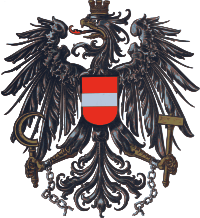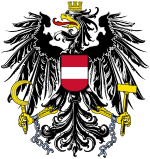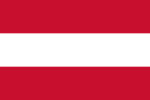You can help expand this article with text translated from the corresponding article in German. (June 2019) Click [show] for important translation instructions.
|
| Wappen der Republik Österreich (Bundeswappen) Coat of arms of the Republic of Austria | |
|---|---|
 | |
| Versions | |
 Bundeswappen like the heraldic description in Art. 8a Abs. 2 B-VG but with detailed eagle's feathers | |
 Bundeswappen like the heraldic description in Art. 8a Abs. 2 B-VG with simplified eagle's feathers | |
 The banner of arms, which serves as national flag | |
| Armiger | Republic of Austria |
| Adopted | 1984 (1945) |
| Shield | Gules, a fess Argent |
| Supporters | An eagle displayed sable, armed Or, langued Gules, crowned with a Mural crown of 3 turrets Or, bound at the wrists by shackles with broken chains proper, holding in dexter a sickle and in its sinister a hammer all Or. |
| Earlier version(s) |   |
The current coat of arms of the Republic of Austria has been in use in its first forms by the First Republic of Austria since 1919. Between 1934 and the German annexation in 1938, the Federal State (Bundesstaat Österreich) used a different coat of arms, which consisted of a double-headed eagle (one-party corporate state led by the clerico-right-wing Fatherland Front, often labeled Austro-fascist).
The establishment of the Second Republic in 1945 saw the return of the original arms, with broken chains added to symbolise Austria's liberation. In 1981 the Wappen der Republik Österreich (Bundeswappen) described the blazon in the Federal Constitutional Law (Austrian act) (Bundes-Verfassungsgesetz, B-VG). With this change of law it was defined that the specific drawing is to codificate in an own statute law and that all other versions of the coat of arms of Austria were no longer in law. In accordance to this the Wappengesetz from 1984 and the drawing of the actual Wappen der Republik Österreich is in Austrian law. The often used Bundesadler (federal eagle) is only a synonymous term in colloquial language.